Body Development from Birth to 18 Months of Age of Thoroughbred Foals in Brazil
Article Information
Luciana L Dias de Castro1ϯ, Carolina LH Abrahão2ϯ, Joaquim Antunes3, Izanara Pritsch2, Marcelo B. Molento2*
1Laboratory of Parasitology, University of Caxias do Sul, Caxias do Sul, Rio Grande do Sul, Brazil.
2Laboratory of Veterinary Clinical Parasitology, Federal University of Parana. Rua dos Funcionários, 1540. CEP: 80.035-050. Curitiba, Parana, Brazil.
3Private Veterinary Doctor, São José dos Pinhais, Paraná, Brazil.
ϯ These authors contributed equally to the development of this manuscript.
*Corresponding Author: Marcelo B. Molento, Laboratory of Veterinary Clinical Parasitology, Federal University of Parana. Rua dos Funcionários, 1540. CEP: 80.035-050. Curitiba, Parana, Brazil
Received: 23 June 2021; Accepted: 1 July 2021; Published: 13 July 2021
Citation: Luciana L Dias de Castro1, Carolina LH Abrahão, Joaquim Antunes, Izanara Pritsch, Marcelo B Molento, Body Development from Birth to 18 Months of Age of Thoroughbred Foals in Brazil. International Journal of Plant, Animal and Environmental Sciences 11 (2021): 352-362.
View / Download Pdf Share at FacebookAbstract
Body development of foals is a predetermined genetic factor, but growth rate may be influenced by environmental and nutritional factors. The objective of this work was to determine the body development (body weight and withers height) of 119 Thoroughbred foals from Paraná, Brazil. The body development data were obtained monthly from the animals’ first 24h until they reached 18 months, from 2008 to 2012. The variables were analyzed by ANOVA and the Tukey test. The animals were born from July to November, and the animals born in November, both males that reached 6 months of age and females that reached 12 months, showed the lowest weight (P ≤ 0.03). Fillies were taller and heavier than colts, with statistical differences only at birth (body weight, P = 0.0091; height, P = 0.0065). The colts and fillies showed 9.8 and 11.3% of their adult weight at birth, and 44.7 and 49.6% at 6 months, respectively. Colts had 61.8% and fillies had 68.7% at 12 months; and 65 and 89.1% when they reached 18 months. The present research data can be used as a reference to the national Thoroughbred databank, to better monitor the development of young animals. The data also demonstrates that the body development of foals in Brazil is similar to those of the USA, England, Australia, and New Zealand.
Keywords
Performance; Racehorse; Growth; Equine; Brazil
Performance articles; Racehorse articles; Growth articles; Equine articles; Brazil articles
Article Details
1. Introduction
Horses usually reach physical maturity at four to five years of age [1], and the maximum body size is mostly genetically predetermined. The growth rate may be influenced by factors such as environmental, nutrition, health, and local management [2, 3]. In the case of animals for horse racing, such as Thoroughbreds, the breeders select these animals to become athletes, as early as possible with training and competitions starting at approximately 24 to 28 months of age. For this, all nutritional and health management is aimed to accelerate the foals’ growth rate [1]. The development of young animals is mainly evaluated by traits such as age, body weight and height at the withers or garrote [4].
Previous studies on the growth rate of Thoroughbred horses have been limited to populations mainly located in the Northern hemisphere [2-5], as fewer data is available from populations in Australia, New Zealand [6], and Brazil [7]. However, this information is extremely important for Brazilian and South American breeders, since the financial movement around horse racing generates approximately US$ 164 million/year, representing 5% of the horse agribusiness just in Brazil [8].
The aim of this study was to determine the body development (body weight and withers height) of young Thoroughbred horses, correlating the gender and month of birth of the animals, between 2008 to 2012 from São Jose dos Pinhais, state of Paraná, Brazil.
4. Materials and methods
For this study, five generations of horses were followed in a breeding farm located in São José dos Pinhais, state of Parana, South of Brazil. The data from 119 foals were gathered from birth to 18 months, from 2008 to 2012. Each year corresponded to a new foal generation. The sample compromise a total of 60 males and 59 females, which were born in the specific year and remained in the farm until the age of 18 months (Table 1). The births were from July to November of each corresponded year.
All animals were born and kept in the same farm with similar management and nutritional status, differing in year and month of birth, mare and stallion. All animals were kept on ryegrass (Lolium multiflorum) with white clover (Trifolium repens) pasture, during
winter and ‘bahia grass’ (Paspalum notatum), dallisgras (Paspalum dilatatum) pastures during summer. In addition, the horses received oat grain (Avena sativa), protein and minerals from a premix and alfalfa hay (Medicago sativa) twice a day, equivalent to 2.5 to 3% of body weight and water ad libitum. All foals were weaned at 6 months of age, when they were separated into groups of males and females.
The body weight was measured using a mechanical weight scale and the withers height was measured with the aid of a hypsometer. Both measurements were performed monthly, from within the first 24 hours (day 1) until the last month of the animal at the horse farm. The data of body weight and withers height of the animals were provided by the veterinarian responsible for the farm and checked by our team. The protocol for this study was approved by the Ethical Committee for Animal Experimentation of the Federal University of Parana, Brazil (number 035/2014).
Data were analyzed in four periods: birth (24h), 6, 12 and 18 months of age. For the ‘period’, the data relating to animals of all generations were grouped. For the statistical evaluation of the paternal effect, gender, month and year of birth, the data was analyzed according to the analysis of variance (ANOVA), in a completely randomized design with 5% significance level, followed by the Tukey test, using Statistix 10.0.1 software.
3. Results and discussion
The body weight and the withers height of all animals are described on Table 2. During all periods of assessment, it was observed that females were significantly taller (P = 0.0065) and heavier (P = 0.0091), than males only in weight and height at birth. Garcia et al. (2011), evaluated the body development of Thoroughbred foals at birth, 6, 12 and 18 months of age and reported, unlike the present study, that males were taller and heavier than females in Bagé, state of Rio Grande do Sul. Pagan et al. (2009), have also determined that males were taller and heavier than females, but the evaluations were performed at 7 days, 1, 2, 3, 4 and 5 months of age, in Kentucky, USA.
Considering that the average body weight and withers height of adult animals is 550 kg and 1.62 m for the males and 500 kg and 1.60 m for females (NRC, 1989) at birth, male foals in this study had 9.8% and females had 11.3% of their adult weight; when they reached 6 months, males and females achieved 44.7 and 49.6%, respectively; at 12 months. The animals had 61.8% (colts) and 68.7% (fillies), and 65.6 and 89.1% at 18 months of age, respectively (Figure 1).
The growth of the animals showed a strong linear increase, having a correlation coefficient of (R2) 0.9778. The results are similar to those observed in Brazil [7], and the USA [4]. Regarding withers height, colts and fillies had on average 63.1 and 64.8%, 94.9 and 85.3%, 90.4 and 92.3%; and 95.2 and 97.2% of the adult height at birth, 6, 12 and 18 months, respectively, showing an optimal R2 = 0.912 (Figure 2).
Thoroughbred horses raised in India were significantly smaller than those from Australia [9], probably due to differences in their nutritional regimen [10]. Another evidence that foals from Brazil may be compared to other countries, was that the average weight of the horses from the present study at 18 months of age were 7.9 times higher than their birth weight. In Australia and India, foals were 6.6 and 6.5 times heavier for that age, respectively [9].
At six months of age, when the animals were weaned, only males born in November were lighter than the animals born in the previous months (P = 0.0002) (Table 3). At 12 months of age, females born in September and October were significantly heavier than animals born in the other months, and those born in November were the lightest (P = 0.03). When evaluating the withers height, it was observed that there were no significant differences for any of the birth month for both genders.
[11], evaluated the effect of the month of birth on the growth of Thoroughbred foals in Australia, from neonate animals to up to 18 months. The foals born in November (Australian summer) were significantly lighter than all the others at six months of age. This finding is similar to the present study, since animals born in November, both males that reached 6 months of age and females that reached 12 months, showed the lowest weight. [12], evaluated the effect of the month of birth on body development of 110 colts from the Pantaneiro horse, born in areas of native grasslands of Pantanal, Brazil and observed that animals born in September were taller and heavier at weaning. This was related to higher pasture offer in the region and better pasture quality in September. Furthermore, the foals born in December, a period of low supply of pasture for the mares, had a reduction of their body development. This was similar to what happened to the animals born in November in our study.
The difference in the weight of the animals born in November, observed in the present study, may be related to a reduction of milk production by mares due to a lower protein and energy intake. During the milking period, the mares that gave birth from July to October had more contact with temperate pastures (C3 plants), which have higher digestibility [13], and more access time to legumes (White clover), which have a lower content of neutral detergent insoluble fiber and a higher crude protein content [14]. These nutrient supplies could positively influence the milk production of the mares and consequently have enhanced the development of their foals until weaning.
The average values of the wither height and body weight of the horses according to the year of birth, from birth to 18 months of age are described in Figure 3 and 4, respectively. The year of birth (Year effect) did not influence the body development of the animals for the five generations (P > 0.05). This data is unique, and more studies are needed in other conditions and countries.
In Figure 5a, it is shown the average monthly weight gain (AMG) of all Thoroughbred animals from the first measurement up to 17 months. The AMG showed different slopes during the development of the animals, varying from 38 to 12 kg/month. The daily weight gain was more pronounced in the first month, when the animals gained on average 1.28 kg/day and at 14 months with a gain of 0.72 kg/day. The polynomial analysis of the data revealed a moderate correlation, with a R2 = 0.68339. [15] reported that the world average for the weight gain in Thoroughbred foals was 1.5 kg/day in the first month and 0.7 kg/day in the 13th month (Figure 5b). In India, the average weight gain was 1.3 kg/day in the first month and 0.58 kg/day in the 13th month. The present results suggest that the animals from Brazil showed a weight gain comparable to foals raised in the USA, England, Australia, and New Zealand, and slightly above India.
The height data (Figure 5b) of the present study shows that the animals in Brazil, in the first month of life, had a mean height of 109.1 cm. The growth rate had a significant decline high until the 6th month (P < 0.05), when they were weaned. The monthly height showed a constant rate from the 7th to the 14th month, growing almost 2cm/month, when the animals reached full maturity size (above 18 months). The polynomial analysis of the data revealed a very strong correlation with a R2 = 0.9811. The present data is similar to foals from Australia (110.9 cm), and superior to horses of other studies (106.1 cm), as determined by Brown-Douglas et al. (2009), which evaluated approximately 13.5 thousand animals from 10 generations. In Brazil, when foals reached 18 months of life, the animals measured 155.5 cm, similar to Australian (156 cm), and Kentucky (154.7 cm) animals, but taller than animals from England (153.1 cm), and India (151.2 cm).
|
Generation |
Male |
Female |
Total |
|
2008 |
9 |
12 |
21 |
|
2009 |
12 |
11 |
23 |
|
2010 |
16 |
11 |
27 |
|
2011 |
10 |
16 |
26 |
|
2012 |
13 |
9 |
22 |
|
Total |
60 |
59 |
119 |
Table. 1: Description of male and female Thoroughbred foals born between 2008 and 2012 (generation/year) from São José dos Pinhais, PR, Brazil.
|
Body weight (kg) |
Withers height (cm) |
|||||
|
Age |
Male |
Female |
P |
Male |
Female |
P |
|
Birth |
53.8 ± 5.9 |
56.6 ± 5.6 |
0.0091 |
102.2 ± 3.4 |
103.6 ± 2.4 |
0.0065 |
|
6 Months |
243.8 ± 20.7 |
248.2 ± 18.3 |
0.2253 |
135.8 ± 3.6 |
136.4 ± 2.7 |
0.2694 |
|
12 Months |
337.2 ± 19.2 |
343.6 ± 19.8 |
0.8961 |
146.5 ± 2.8 |
147.6 ± 2.8 |
0.5867 |
|
18 Months |
432.7 ± 22.2 |
445.5 ± 30.8 |
0.1746 |
154.2 ± 3.2 |
155.5 ± 3.1 |
0.943 |
Table. 2: Mean and standard deviation of the body weight (kg) and withers height (cm) of Thoroughbred foals according to gender of four categories, from 2008 to 2012 in São José dos Pinhais, PR, Brazil.
|
Jul. |
Aug. |
Sep. |
Oct. |
Nov. |
||
|
Birth |
Male P = 0.88 |
54.0 ± 6.3 |
52.2 ± 5.6 |
54.0 ± 5.6 |
54.1 ± 6.70 |
56.0 ± 1.0 |
|
Female P = 0.11 |
54.8 ± 5.2 |
55.6 ± 5.6 |
59.4 ± 5.7 |
56.5 ± 5.2 |
64.0 ± 1.5 |
|
|
6 M |
Male P = 0.0002 |
259.4A ±14.9 |
241.0A ±14.6 |
234.0A ±19.3 |
241.1A ±20.8 |
215.9B ±15.4 |
|
Female P = 0.54 |
247.6 ± 16.9 |
248.3 ± 18.3 |
251.9 ± 17.4 |
246.8 ± 21.3 |
219.0 ± 18.6 |
|
|
12 M |
Male P = 0.43 |
350.7 ± 19.6 |
341.9 ± 19.0 |
338.8 ± 20.4 |
342.2 ± 24.1 |
330.9 ± 9.8 |
|
Female P = 0.03 |
336.0B ±19.5 |
336.4B ±21.5 |
355.4A ±18.5 |
348.4A ±14.1 |
326.0C ±12.5 |
|
|
18 M |
Male P = 0.63 |
448.8 ± 28.5 |
437.2 ± 14.4 |
436.6 ± 23.3 |
441.2 ± 25.7 |
429.5 ± 0.7 |
|
Female P = 0.06 |
445.3 ± 26.3 |
436.4 ± 29.1 |
464.2 ± 26.1 |
452.3 ± 21.4 |
450.0 ± 20.1 |
|
Table. 3: Average weight (kg) and standard deviation of Thoroughbred foals according to gender of four age categories (M = month), evaluated by month of birth from a horse farm located in São José dos Pinhais, PR.
*Different letters in the same line indicate statistical difference (p<0.05).
5. Conclusion
From the results of the present study, we report that the month of birth influenced the development of the animals, probably due to a better forage quality during the winter. There was no effect of year of birth or sex over the body development of the foals. Average daily weight gain was 1.28 kg/day in the first month and 0.72 kg/day at 14 months. The weight
of the horses at 18 months was 7.9 times higher than their birth weight. At 18 months of age the weight for males and females were 432.72 and 445.45 kg and a height of 154.18 and 155.51 cm, respectively. This study may contribute to establish a body development reference data to the national Thoroughbred Association of Brazil, due to the long experimental period of measurements. In addition, these results indicate that the development of foals in Brazil are similar to those in other countries from different continents.
Acknowledgements
The authors wish to thank the HSJS Stud team for their technical support and data supply; to Dr. Paulo Guimarães of the Statistics Department of UFPR for his assistance in the statistical analysis; and the support of CAPES to the Dr. of L. L. Dias de Castro and the M.Sc. of C. L. H. Abrahão.
References
- Pagan JD, Nash D. Managing Growth to Produce a Sound, Athletic Horse. Adv Eq Nutr 6 (2009): 247.
- Hintz R, Hintz H, Van Vleck LD. Estimation of heritabilities for weight, height and front cannon bone circumference of Thoroughbreds. J Anim Sci 47 (1978): 1243–1245.
- Hintz RL, Hintz HF, Van Vleck LD. Growth rate of thoroughbreds, effect of age of dam, year and month of birth, and sex of foal. J Anim Sci 48 (1979): 480-487.
- Pagan JD, Jackson SG, Caddel SA. Summary of growth rates of thoroughbreds in Kentucky. Proceeding of the 2nd European Conference on Equine Nutrition 12 (1996): 85–289.
- Green DAA. Study of Growth Rate in Thoroughbred Foals. Brit Vet J 125 (1969): 539–546.
- Brown-Douglas CG, Parkinson TJ, Firth EC, et al. Bodyweights and growth rates of spring- and autumn-born Thoroughbred horses raised on pasture. New Zeal Vet J 53 (2005): 326–331.
- Garcia FPS, Alfaya H, Lins LA, et al. Determinação do crescimento e desenvolvimento de potros puro sangue inglês em Bagé-RS Growth and development rates in thoroughbred foals in Bagé-Brazil. Rev. Port. Ciên. Vet 110 (2011): 43–46.
- Lima RAS, Shirota R, Barros GSC. Estudo do complesxo do agronegócio cavalo. Piracicaba: ESALQ/USP (2006): 291.
- National Research Council. In: Subcommittee on Horse Nutrition (Ed.); Washington: National Academic Press (1989).
- Brown-Douglas CG, Pagan JD, Stromberg AJ. Thoroughbred Growth and Future Racing Performance. Adv Equi Nutr 4 (2009): 231–245.
- Jelan ZA, Jeffcott LB, Lundeheim N, et al. Growth rates in Thoroughbred foals. Pferdeheilkunde 12 (1996): 291-295.
- Huntington P, Brown-Douglas C, Pagan J. Growth of Australian Thoroughbreds compared with horses in New Zealand, American, England, and India. Australian Eq Vet 26 (2007): 80–92.
- Santos, S.; Abreu, U.G.; Mascioli, A.S. et al. Fatores ambientais e crescimento de cavalos pantaneiros criados em condiçoes naturais. Arch Zootec 56 (2007): 929–934.
- Basso KC, Barbero LM. Anatomia foliar de forrageiras e a sua relação com o valor nutritivo. Vet. Not 21 (2015): 1–10.
- Ribeiro Filho H. M. N. Nutrição de vacas leiteiras em pastagens: avaliação da introdução do trebo branco em função do manejo adotado no pastejo. Universidade Federal do Rio Grande do Sul. Porto Alegre-RS (2003).
- Pagan J, Brown-Douglas C, Caddel S. Body weight and condition of Kentucky Thoroughbred mares and their foals as influenced by month of foaling, season, and gender. Adv Eq Nutr 4 (2009): 137–145.

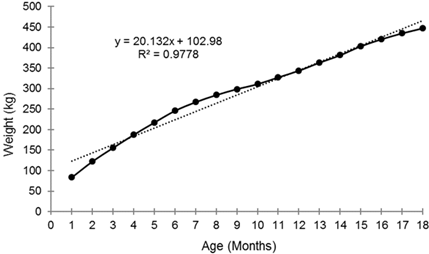
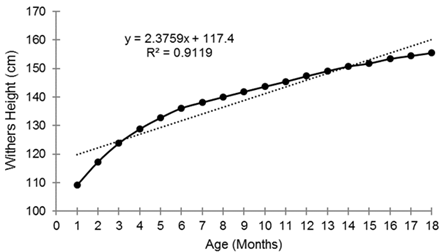
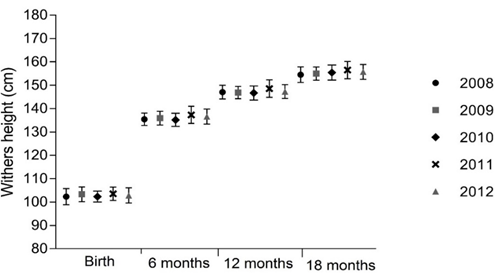
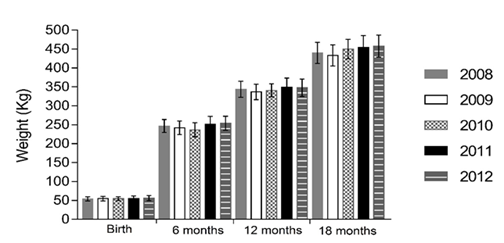
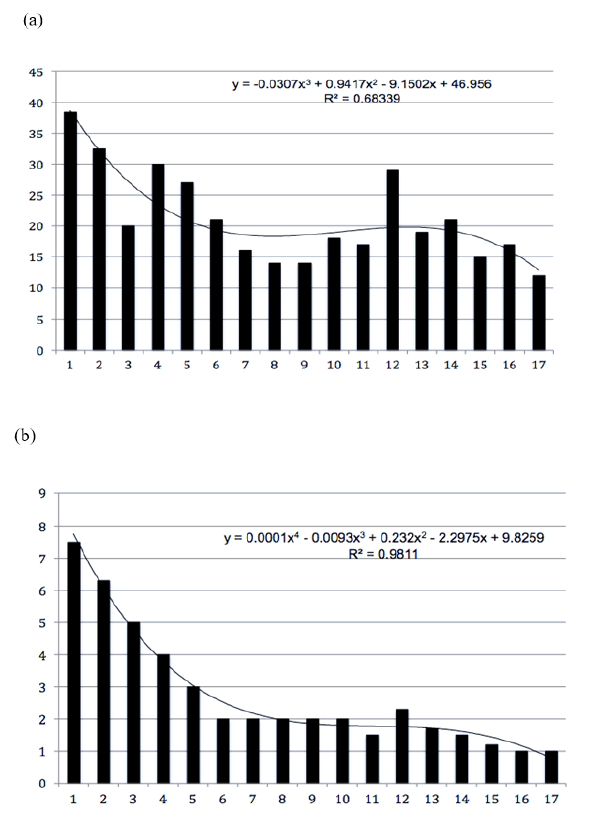
 Impact Factor: * 3.6
Impact Factor: * 3.6 CiteScore: 2.9
CiteScore: 2.9  Acceptance Rate: 11.01%
Acceptance Rate: 11.01%  Time to first decision: 10.4 days
Time to first decision: 10.4 days  Time from article received to acceptance: 2-3 weeks
Time from article received to acceptance: 2-3 weeks 